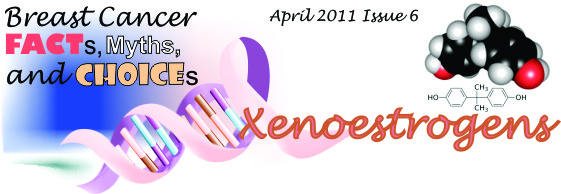 Many xenoestrogens (chemicals which the body is tricked into thinking is estrogen) can pose risk for breast cancer. One such chemical is bisphenol- A, (Figure 1) which can interfere with normal estrogen-dependent functions. The increasing prevalence of xenoestrogens in the environment may partly explain the increasing incidence of breast cancer, though direct evidence is not overwhelming.
Many xenoestrogens (chemicals which the body is tricked into thinking is estrogen) can pose risk for breast cancer. One such chemical is bisphenol- A, (Figure 1) which can interfere with normal estrogen-dependent functions. The increasing prevalence of xenoestrogens in the environment may partly explain the increasing incidence of breast cancer, though direct evidence is not overwhelming.
The use of bisphenol-A (BPA) in the production of plastics began around 1891 (e.g. in baby bottles, food containers, water main pipes, and laboratory and hospital equipment). Its estrogen-like (in this case, estrogen-disrupting) effects began to be noticed in the 1930s. Prenatal exposure to BPA (in rats and mice) changed mammary tissue and led to cancers in adulthood. Other animal studies used BPA to show that when breast cancer has been induced by a carcinogen that risk was increased further. If the animal studies correlate with humans, then even a small exposure to BPA could cause an increased risk for breast cancer.
Exposing cells in culture to BPA can cause neoplastic transformation of human breast epithelial cells.
“Consumer groups recommend that people wishing to lower their exposure to bisphenol A avoid canned food and polycarbonate plastic containers (which are identified as , unless the packaging indicates the plastic is bisphenol A-free. The National Toxicology Panel recommends avoiding microwaving food in plastic containers, putting plastics in the dishwasher, or using harsh detergents on plastics, to avoid leaching”. (thanks wiki)
Some estimate that 92% of canned goods with plastic liners have BPA. WHEN THE BRAND NAME on your canned soup is “Healthy Choice” and the BPA is 323 ppm, it’s kind of sad. I think its going to be a while before companies get the message…. therefore BUY FRESH
http://organicgrace.com
http://treehugger.com
HERE IS THE PDFPRG-DEH_Issue_6